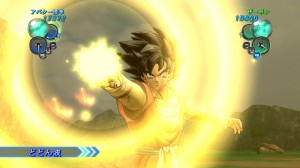 A baby from another planet, sent in a spaceship to Earth. The child is raised by his adopted caretaker, instilled with strong morals, and taught to fight for good. As he matures he gains strange new powers, and learns the importance of friendship. As a man, he encounters terrible and horrific villains, even dies, and several times over, becomes the saviour of Earth. No, this isn’t the story of Superman, it’s the story of Goku. Goku is the main character of the Dragon Ball franchise, and this year, Namco Bandai presents Dragon Ball Z: Ultimate Tenkaichi.
A baby from another planet, sent in a spaceship to Earth. The child is raised by his adopted caretaker, instilled with strong morals, and taught to fight for good. As he matures he gains strange new powers, and learns the importance of friendship. As a man, he encounters terrible and horrific villains, even dies, and several times over, becomes the saviour of Earth. No, this isn’t the story of Superman, it’s the story of Goku. Goku is the main character of the Dragon Ball franchise, and this year, Namco Bandai presents Dragon Ball Z: Ultimate Tenkaichi.
The Dragon Ball universe, to me, is home to one of the most diverse collections of characters in any type of media today. From Dragon Ball, to Dragon Ball Z, to even Dragon Ball GT, the amount of characters, both heroes and villains, introduced, and stay recurring, is huge. The Story of Dragon Ball follows Goku from pre-pubecence to adulthood, something that many modern day stories, be it cartoon, anime, or comics, don’t do. And it’s with this rich history backing the Dragon Ball franchise, that makes me disappointed in what DBZ (Dragon Ball Z): Ultimate Tenkaichi has to offer.
When you start the game you’re greeted by the original Dragon Ball Z Japanese opening theme, which is an intro video that’s inspired by the anime. A side note to this, the intro video, and all the animated cut scenes in the game, are some of the most clear and crisp animations I’ve ever seen, not just of Dragon Ball, but of any animation in a game, period. They’re beautiful, and I really want to find Dragon Ball Z DVDs with this kind of production value.
After the intro, a prompt comes up asking which storage device you’d like to save your game at. This is important, as DBZ Ultimate Tenkaichi doesn’t allow for separate game saves like most games. So where you save your game, it’ll be saved as such unless you delete it. Once you get past this you get into the main menu, which consists of Story Mode, Hero Mode, Battle Mode, World Tournament Mode, Customize, Online Battle, Capsule House, Options, and Training.
Customize is an interesting addiction. Customize lets you do exactly what it says, customize parts of the game to your catering. It lets you set up a BGM medley, which is like a 3 track playlist, selected from the music available in game. This lets you set up about 10 separate BGM playlists which will be the songs that play during your fights. Also available in Customize is the ability to create skill sets, 10 re-namable skill set files, that can be applied to characters you use in Battle Mode. Skills are acquired through Hero Mode, which I’ll get into later.
The main modes of this game are Story Mode, and Hero Mode. Both modes use an open world map, where you fly around between story points and explore the world. Within this map is a special mechanic. If you’re using a character that has possession of a Dragon Radar you can find your next mission in the story, or random battles happening on the map that you can fight in, or Dragon Balls. In staying true to its inspiration, collecting Dragon Balls in the open world map will allow you to redeem a “wish.” As a hint, every time you’re in the map, try to find Dragon Balls. The wish you get when you collect all 7 Dragon Balls basically allows you to unlock some fight environments or alternate costumes for some of the characters. More about the map will be talked about when I talk about Hero Mode.
Story Mode is a funny little mode, due to the fact that, the setup to the plot points are all told through scrolling text, which lead to the major plot points which are played out by the in game models, and usually lead into a playable fight. The chapters in this mode are derived from story arcs in the anime series, but a few chapters come from DBZ movies that had no bearing on the story of the anime, aside from the movie about Goku’s father.
If you know the story of Dragon Ball Z, you know where the Story Mode’s going. If you don’t, I’ll just say that the Story Mode is a VERY abridged version, and if you really want to know the story how it was meant to be, rent the season DVDs or Dragon Ball Kai, or check out the manga. The Story Mode basically ends at the Buu Saga, with a couple extra chapters afterwards, and there’s a very, very, minimal presence of Dragon Ball GT in this game. Overall, I disliked the presentation of the story in this mode. The setups to the fights were very generic, all in text form, with generic music playing, with a few animated cut scenes showing the really dramatic stuff that couldn’t be done in game.
Hero Mode is, what the game calls, a parallel Dragon Ball World. This mode allows you to create your own character, and go through a Story Mode where your character wants to “change the world.” While the premise of this mode is awesome, the execution seems flat. You start off by picking your body type. The body type break down to a small, medium, and large build. There are no female body types so there’ll be no female Saiyans flying around trying to save the world. The options for your character are very lacking. First you pick your body type. Three hairstyles; bed hair, which is Goku’s hair style, wild hair, which is Vegeta’s hair style, and bald. Once you pick your hair, you can pick skin tone and outfit. The outfits available are the two gi styles that Goku wears through the series, with the odd addition of a Saiyan tail. The other outfit styles are called native. One looks similar to Broly’s outfit style, with the baggy pants, and some kinda wrap around, that looks like the top of a gi just wrapped around the waist, and the other outfit IS Broly’s outfit.
Once you’ve made your character, you’re saddled with a default set of super moves, and a training “master,” which is a character from DBZ. The training thing is very useful, because it’s through training that you gain new skills and new super moves. The skills unlocked here can be used in your character’s skill set, or used in customization for skill sets to be used with other characters. As you master your training masters, you unlock new masters, and each master has an effect on the skills your character has in Hero Mode.
Whether you train or not, Hero Mode offers a story that has your character trying to save the world after it’s been thrown into Chaos. Much like Story Mode, you can fly around the map looking for your missions that go with the story of the mode, or you can do the battles that are around the map. Battles are helpful because they boost up the stats of your character, if you win. And, once you get the Dragon Radar, you can find the Dragon Balls in this mode too. The Dragon Balls found in Hero Mode don’t count toward the Dragon Balls found in Story Mode.
Also found through the map and the Dragon Radar, are spots on the map that look like Dragon Balls, but they’re actual unlockables for your character in Hero Mode. These unlockables could be new hair styles, or new outfit choices. So, really, if you want your character to look a certain way, you need to play through Hero Mode and unlock all the extra stuff to get him looking, and fighting, how you ultimately want him to be.
,
In terms of graphics, DBZ Ultimate Tenkaichi is beautiful. The character models look to have depth while still keeping the look of their anime/manga inspiration. And the backgrounds, i cannot stress how beautiful the backgrounds look, especially the middle of no where grassy fighting stages where there’s green grass, and blue skys, and the clouds drifting in the sky, even though they aren’t really moving, look insanely realistic. The real impressive thing about the fighting stages and backgrounds, is that they’re all destructible, which I’ll get into later.
To someone who doesn’t know a lot about DBZ, it’d be easy to say that a game based on this franchise could just be a fighting game in the vain of Street Fighter, or Mortal Kombat. Maybe even Tekken. But for people who know what DBZ delivers in terms of combat, especially from the anime, there’s just no way to break down its fighting mechanics to just a “lets fight on this 2D plane” kind of game.
And it’s in that fact that a lot of the DBZ games have trouble keeping up. When I started up DBZ, it suggested that i check out the tutorial, which told me I better do that to get used to the fighting system. Going into the tutorial, you find that your character can move in a 3D plane, side to side, foreground and background. The fighting Mechanic, at it’s core, is made up of a basic starting base. Rush Attack (light attack), Smash Attack (hard attack), Defense (block), and Super Attacks. Then you get into the mechanics that are unique to DBZ.
In DBZ there are two ranges of attack. There is a Melee Range, where you can attack upclose, and Blast Range, where you can use energy blasts, called Ki Blasts. Your Ki can be build up manually during a fight, but building up your Ki leaves you open for any and all attacks by your opponent. Ki is important to goign Super Saiyan, and also to defense with Super Attacks, which I’ll get into later. Also in Blast Range is where you find the most unique thing about fighting in DBZ games, flying. You can stay on the ground throwing your Ki Blasts, or you can ascend, fly up, and shoot the blasts from in the air. In either range, once you hit four rush attacks in a row, you get put into a mini game/quicktime event.
From this quicktime event prompt, you can pick either rush or smash attack, which will lead into an Attack Chain, but, if the opponent picks the same attack you pick, they’ll end up hitting you, and you have to try to beat them up again to get back into that mini game/quicktime event. Once you win this little game your character starts an Attack Chain, which is preformed through more quicktime events, which all come together in a combo. The Attack Chains are one of the most important parts of the combat system. They weaken your opponent, and build up your Spirit Gauge.
The Spirit Gauge is important for your Super Attacks. Super Attacks are almost as important, if not more important, than the Attack Chains. Your Super Attacks are what give the most damage, and when your Spirit Gauge is completely filled, you can release your Ultimate Attack, which is basically a finishing move. And it’s with the Super Attacks and Ultimate Attacks, that the destructible environments come into play. A beautiful landscape of grassy hills and fields, trees and lakes, reduced to craters, or a giant crater, with one Super Attack. It’s truly beautiful in it’s destruction. And that’s one of the best things about this game.
However, one of the worst things about this fighting system is the defence fighting mechanics. Basically, your defence is a block button, which will automatically dodge Melee Rush Attacks and Blast Rush Attacks. You cannot move while you block, at all. When flying, if you’re quick enough, you can fly out of the way of Ki blasts and then send some of your own. But if you get caught by your opponent and they start an Attack Chain on you, a button prompt pops up saying button mash the face button to recover. The less power your character has, the less likely he’ll be able to recover. This mechanic is one of the worst defensive mechanics in the game, because if you are able to recover, you don’t recover until the last chain in the Attack Chain, which basically means, on the last chain, when your character is about to get hit, he teleports behind the opponent, which the opponent is able to counter. If they counter, you can also counter their counter by pressing the face button the game tells you to, when it reaches the end of a gauge. I wish I could think of a better way for this defense to be laid out and executed, but I know for sure the button mashing needs to be replaced.
The only good defensive mechanic in the game is the mechanic for defending against Super/Ultimate Attacks. This mechanic requires you to build up your Ki meter, which has 3 little symbols on it in the HUD. These symbols stand for the defense options available to combat against Super/Ultimate Attacks. The first defence is “defend.” This is your character blocking the attack, and taking as much damage as a full blown attack would deal. The second defence maneuver is “evade.” Evade brings up a bar at the button of the screen with a lighted box near the edge of the screen. 1-3 markers scroll across this bar and you need to press the button it tells you to press, when the markers enter this lighted box. If you do it right, your character sidesteps the attack. If you do it wrong, your character takes the full brunt of the blow. The third defence maneuver in the Ki Meter is “Intercept.” Your Ki Meter needs to be almost full to be able to use this, and if you’re able to, it makes for one of the few dramatic scenes in any battle. Intercept makes your character attempt their own Super Attack against the opponent’s Super Attack. This causes a tug of war style battle with a bar at the bottom of the screen and you needing to button mash the button it tells you to (usually Y) to make the marker, that starts off in the middle, cross into their area. If you succeed, your Super Attack negates their attack and ends up giving the opponent total Super Attack damage. If you fail, you take the full force of the blow.
This game offers online play, with there being exhibition matches through Player Match, a World Tournament where a number of online players, and CPU players if need be, can battle it out, and Ranked Match, where you battle other online players and try to get better than all of them. There’s a grading system in Ranked Match where you climb up in grade as you win. It seems very similar to Super Street Fighter 4’s ranking system. Sadly, the fighting is not similar to SSF4.
In regular single player fighting, you can sometimes find that there’s an input lag while doing anything in a fight. This lag is especially detrimental to the recovery mechanic. Now when you add this input lag to online play, it becomes compounded with even the slightest internet lag you may have. What this means is, if you’re not on the offensive quickly, and/or you don’t have a controller with a turbo function, you’re dead. I played numerous matches online, where I was having to button mash for recovery, and nothing. Nothing happened. No recovery, just me getting destroyed. Another reason why I say these defense mechanics aren’t very good.
The most important thing about fighting in DBZ Ultimate Tenkaichi, which is really important when it comes to fighting other people, is this; attacking an opponent from the back is the best strategy. This game basically implores you to try to get behind your opponent and attack. By attacking from behind, there’s no quicktime event prompt after your rush attack combo, you go straight into the Attack Chain, and this is the most damaging combo in the game. Because not only do you weaken your opponent, but the Attack Chain combos build up your spirit, which in turn builds up your ability to use Super Attacks.
The music in DBZ Ultimate Tenkaichi is very hit and miss with me. On one hand, you have the original Japanese intro music, Cha-la Head Cha-la. This accompanies the game greatly and makes you feel like you’re very much a part of the game world itself. But then, the rest of the music is generic rock music, that isn’t too uncommon when dealing with japanese made games. In fact, a lot of the music sounds pretty cool, and fits in with the DBZ world nicely, but there are some tracks that seem out of place, and none of them tracks sound like they’re from the actual anime. Personally, I would’ve liked the option to have the American theme “Rock The Dragon” in my BGM medleys.
Overall, Dragon Ball Z: Ultimate Tenkaichi is a beautiful looking game. Graphically, it will always make me want to watch the anime, because it just looks so good. But graphics aren’t everything, and this isn’t the anime or the movies. This is a video game, and video games are meant to be entertaining through it’s gameplay. And DBZ: Ultimate Tenkaichi’s gameplay is not it’s strong suit, at all. From the actual controls in fighting, to the roster, it’s just lacking. The characters and fighting in DBZ is so rich, and deep, there’s no reason that this game couldn’t have, at least, Hercule. At the end of the day, as great as this game is visually, it’s every bit as bad in it’s gameplay.
Gameplay
Graphics
Sound
Overall
Click here to buy Dragon Ball Z Ultimate Tenkaichi for the Xbox 360 online from EBgames.com

Click here to buy Dragon Ball Z Ultimate Tenkaichi new or used from EBgames.com

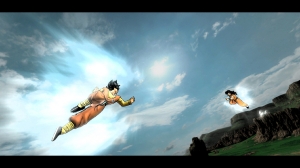

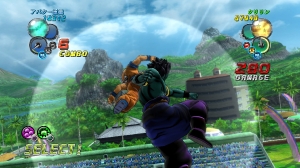
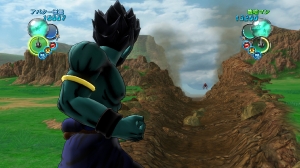
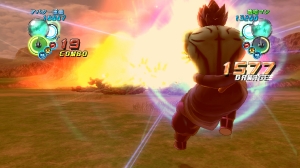
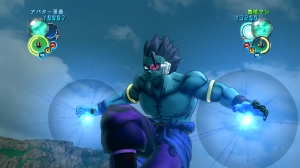
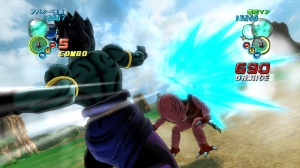
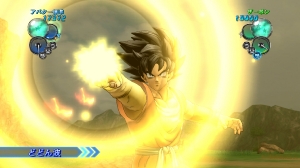


This one seems better than the previous games, it’s getting better at least.